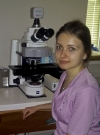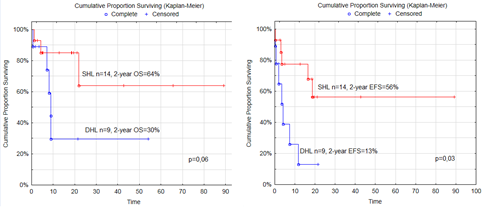SINGLE-HIT LYMPHOMA PATIENTS HAD MORE PRONOUNCED BENEFIT FROM DOSE-INTENSIFIED CHEMOTHERAPY THAN DOUBLE-HIT LYMPHOMA PATIENTS. SINGLE-CENTER EXPERIENCE.
(Abstract release date: 05/19/16)
EHA Library. Misyurina A. 06/09/16; 134619; PB1719

Mrs. Anna Misyurina
Contributions
Contributions
Abstract
Abstract: PB1719
Type: Publication Only
Background
B-cell lymphomas with c-MYC rearrangement are characterized by aggressive clinical behavior and poor prognosis when R-CHOP-21 is used. An efficacy of intensified chemotherapeutic regimens continues to be debatable.
Aims
To represent treatment results of MYC+ agressive B-cell lymphomas with dose-intensified chemotherapy.
Methods
Since 2007 till 2015 years in National Research Center for Hamatology 23 cases of c-MYC rearranged non-Burkitt B-cell lymphomas (5 DLBCL and 18 BCLU intermediate between DLBCL and BL) were diagnosed. Ratio between men and women was 9:14. Median age was 51 years old (30-70). ECOG ≥2 was in 18 (78%) cases; 19 (83%) of pts had III-IV stage according Ann-Arbor classification; 17 (74%) had more than one extranodal site: 7 (30%) - bone marrow involvement, 2 (9%) - CNS; 18 (78%) pts had IPI 3-5. In 15 cases c-MYC translocation partner was locus of IGH gene, in 4 cases – locus of IGL or IGK gene, in 4 cases – undefined. In 8 cases with available karyotype were revealed complex abnormalities. MYC+/BCL2+ double-hit lymphoma (DHL) was in 6 cases, MYC+/BCL6+ DHL was in 3 pts, others 14 pts had single-hit lymphoma (SHL). In all cases dose-intensified treatment strategy was initially chosen: in 4 cases - R-DA-EPOCH and in 19 cases – protocol BL-M-04 consisted of A-C-A-C 4-6 courses (Course A: dexa 10 mg/m2 1-5 days; Mtx 1500 mg/m2 1st day12-hours infusion; ifosfamide 800 mg/m2 1-5 days; vincristine 1 mg/m2 1st day; doxorubicine 50 mg/m2 3rd day; AraC 150 mg/m2 4-5 days bid; etoposide 100 mg/m2 4-5 days, iv. Course C: dexa 10 mg/m2, 1-5 days; Mtx 1500 mg/m2 1st day12-hours infusion; vinblastine 5 mg/m2 1st day; AraC 2000 mg/m2 2-3 days bid; etoposide 150 mg/m2 3-5 days, iv. AraC 30 mg, Mtx 15 mg, dexa 4 mg 1st day of each course, intrathecally). Rituximab was indicated in 12/19 cases. AutoSCT was performed in 5 cases. Kaplan-Meier method and log-rank test were used to estimate treatment results (SAS 9.3).
Results
9/23 (39%) pts had a complete remission, 6/23 (26%) pts had a partial remission, 7/23 (30%) pts had disease progression (in one case after autoSCT), one pt (4%) died from infectious. In one case (4%) of DLBCL early relapse had occurred. 2-year overall survival (OS) and event-free survival (EFS) were 51% (median - 9,0 months (0,6-89,1)) and 40% (median 7,3 months (0,1-89,1)), respectively. DHL pts had worse treatment results compared with SHL pts: 2-year OS was 30% (median – 8,2 months (0,6-54,1)) vs 64% (18,6 months (1,1-89,1)) in DHL vs SHL groups, respectively (p=0,06) (Picture 1). 2-year EFS was 13% (median – 3,5 months (0,3-21,4)) vs 56% (median 17,4 months (0,1-89,1)) in DHL vs SHL groups, respectively (p=0,03) (Picture 1).
Conclusion
Single-hit lymphoma patients have more pronounced benefit from dose intensification compared with miserly results in double-hit lymphoma patients.

Session topic: E-poster
Keyword(s): MYC, Non-Hodgkin's lymphoma, Rituximab, Therapy
Type: Publication Only
Background
B-cell lymphomas with c-MYC rearrangement are characterized by aggressive clinical behavior and poor prognosis when R-CHOP-21 is used. An efficacy of intensified chemotherapeutic regimens continues to be debatable.
Aims
To represent treatment results of MYC+ agressive B-cell lymphomas with dose-intensified chemotherapy.
Methods
Since 2007 till 2015 years in National Research Center for Hamatology 23 cases of c-MYC rearranged non-Burkitt B-cell lymphomas (5 DLBCL and 18 BCLU intermediate between DLBCL and BL) were diagnosed. Ratio between men and women was 9:14. Median age was 51 years old (30-70). ECOG ≥2 was in 18 (78%) cases; 19 (83%) of pts had III-IV stage according Ann-Arbor classification; 17 (74%) had more than one extranodal site: 7 (30%) - bone marrow involvement, 2 (9%) - CNS; 18 (78%) pts had IPI 3-5. In 15 cases c-MYC translocation partner was locus of IGH gene, in 4 cases – locus of IGL or IGK gene, in 4 cases – undefined. In 8 cases with available karyotype were revealed complex abnormalities. MYC+/BCL2+ double-hit lymphoma (DHL) was in 6 cases, MYC+/BCL6+ DHL was in 3 pts, others 14 pts had single-hit lymphoma (SHL). In all cases dose-intensified treatment strategy was initially chosen: in 4 cases - R-DA-EPOCH and in 19 cases – protocol BL-M-04 consisted of A-C-A-C 4-6 courses (Course A: dexa 10 mg/m2 1-5 days; Mtx 1500 mg/m2 1st day12-hours infusion; ifosfamide 800 mg/m2 1-5 days; vincristine 1 mg/m2 1st day; doxorubicine 50 mg/m2 3rd day; AraC 150 mg/m2 4-5 days bid; etoposide 100 mg/m2 4-5 days, iv. Course C: dexa 10 mg/m2, 1-5 days; Mtx 1500 mg/m2 1st day12-hours infusion; vinblastine 5 mg/m2 1st day; AraC 2000 mg/m2 2-3 days bid; etoposide 150 mg/m2 3-5 days, iv. AraC 30 mg, Mtx 15 mg, dexa 4 mg 1st day of each course, intrathecally). Rituximab was indicated in 12/19 cases. AutoSCT was performed in 5 cases. Kaplan-Meier method and log-rank test were used to estimate treatment results (SAS 9.3).
Results
9/23 (39%) pts had a complete remission, 6/23 (26%) pts had a partial remission, 7/23 (30%) pts had disease progression (in one case after autoSCT), one pt (4%) died from infectious. In one case (4%) of DLBCL early relapse had occurred. 2-year overall survival (OS) and event-free survival (EFS) were 51% (median - 9,0 months (0,6-89,1)) and 40% (median 7,3 months (0,1-89,1)), respectively. DHL pts had worse treatment results compared with SHL pts: 2-year OS was 30% (median – 8,2 months (0,6-54,1)) vs 64% (18,6 months (1,1-89,1)) in DHL vs SHL groups, respectively (p=0,06) (Picture 1). 2-year EFS was 13% (median – 3,5 months (0,3-21,4)) vs 56% (median 17,4 months (0,1-89,1)) in DHL vs SHL groups, respectively (p=0,03) (Picture 1).
Conclusion
Single-hit lymphoma patients have more pronounced benefit from dose intensification compared with miserly results in double-hit lymphoma patients.

Session topic: E-poster
Keyword(s): MYC, Non-Hodgkin's lymphoma, Rituximab, Therapy
Abstract: PB1719
Type: Publication Only
Background
B-cell lymphomas with c-MYC rearrangement are characterized by aggressive clinical behavior and poor prognosis when R-CHOP-21 is used. An efficacy of intensified chemotherapeutic regimens continues to be debatable.
Aims
To represent treatment results of MYC+ agressive B-cell lymphomas with dose-intensified chemotherapy.
Methods
Since 2007 till 2015 years in National Research Center for Hamatology 23 cases of c-MYC rearranged non-Burkitt B-cell lymphomas (5 DLBCL and 18 BCLU intermediate between DLBCL and BL) were diagnosed. Ratio between men and women was 9:14. Median age was 51 years old (30-70). ECOG ≥2 was in 18 (78%) cases; 19 (83%) of pts had III-IV stage according Ann-Arbor classification; 17 (74%) had more than one extranodal site: 7 (30%) - bone marrow involvement, 2 (9%) - CNS; 18 (78%) pts had IPI 3-5. In 15 cases c-MYC translocation partner was locus of IGH gene, in 4 cases – locus of IGL or IGK gene, in 4 cases – undefined. In 8 cases with available karyotype were revealed complex abnormalities. MYC+/BCL2+ double-hit lymphoma (DHL) was in 6 cases, MYC+/BCL6+ DHL was in 3 pts, others 14 pts had single-hit lymphoma (SHL). In all cases dose-intensified treatment strategy was initially chosen: in 4 cases - R-DA-EPOCH and in 19 cases – protocol BL-M-04 consisted of A-C-A-C 4-6 courses (Course A: dexa 10 mg/m2 1-5 days; Mtx 1500 mg/m2 1st day12-hours infusion; ifosfamide 800 mg/m2 1-5 days; vincristine 1 mg/m2 1st day; doxorubicine 50 mg/m2 3rd day; AraC 150 mg/m2 4-5 days bid; etoposide 100 mg/m2 4-5 days, iv. Course C: dexa 10 mg/m2, 1-5 days; Mtx 1500 mg/m2 1st day12-hours infusion; vinblastine 5 mg/m2 1st day; AraC 2000 mg/m2 2-3 days bid; etoposide 150 mg/m2 3-5 days, iv. AraC 30 mg, Mtx 15 mg, dexa 4 mg 1st day of each course, intrathecally). Rituximab was indicated in 12/19 cases. AutoSCT was performed in 5 cases. Kaplan-Meier method and log-rank test were used to estimate treatment results (SAS 9.3).
Results
9/23 (39%) pts had a complete remission, 6/23 (26%) pts had a partial remission, 7/23 (30%) pts had disease progression (in one case after autoSCT), one pt (4%) died from infectious. In one case (4%) of DLBCL early relapse had occurred. 2-year overall survival (OS) and event-free survival (EFS) were 51% (median - 9,0 months (0,6-89,1)) and 40% (median 7,3 months (0,1-89,1)), respectively. DHL pts had worse treatment results compared with SHL pts: 2-year OS was 30% (median – 8,2 months (0,6-54,1)) vs 64% (18,6 months (1,1-89,1)) in DHL vs SHL groups, respectively (p=0,06) (Picture 1). 2-year EFS was 13% (median – 3,5 months (0,3-21,4)) vs 56% (median 17,4 months (0,1-89,1)) in DHL vs SHL groups, respectively (p=0,03) (Picture 1).
Conclusion
Single-hit lymphoma patients have more pronounced benefit from dose intensification compared with miserly results in double-hit lymphoma patients.

Session topic: E-poster
Keyword(s): MYC, Non-Hodgkin's lymphoma, Rituximab, Therapy
Type: Publication Only
Background
B-cell lymphomas with c-MYC rearrangement are characterized by aggressive clinical behavior and poor prognosis when R-CHOP-21 is used. An efficacy of intensified chemotherapeutic regimens continues to be debatable.
Aims
To represent treatment results of MYC+ agressive B-cell lymphomas with dose-intensified chemotherapy.
Methods
Since 2007 till 2015 years in National Research Center for Hamatology 23 cases of c-MYC rearranged non-Burkitt B-cell lymphomas (5 DLBCL and 18 BCLU intermediate between DLBCL and BL) were diagnosed. Ratio between men and women was 9:14. Median age was 51 years old (30-70). ECOG ≥2 was in 18 (78%) cases; 19 (83%) of pts had III-IV stage according Ann-Arbor classification; 17 (74%) had more than one extranodal site: 7 (30%) - bone marrow involvement, 2 (9%) - CNS; 18 (78%) pts had IPI 3-5. In 15 cases c-MYC translocation partner was locus of IGH gene, in 4 cases – locus of IGL or IGK gene, in 4 cases – undefined. In 8 cases with available karyotype were revealed complex abnormalities. MYC+/BCL2+ double-hit lymphoma (DHL) was in 6 cases, MYC+/BCL6+ DHL was in 3 pts, others 14 pts had single-hit lymphoma (SHL). In all cases dose-intensified treatment strategy was initially chosen: in 4 cases - R-DA-EPOCH and in 19 cases – protocol BL-M-04 consisted of A-C-A-C 4-6 courses (Course A: dexa 10 mg/m2 1-5 days; Mtx 1500 mg/m2 1st day12-hours infusion; ifosfamide 800 mg/m2 1-5 days; vincristine 1 mg/m2 1st day; doxorubicine 50 mg/m2 3rd day; AraC 150 mg/m2 4-5 days bid; etoposide 100 mg/m2 4-5 days, iv. Course C: dexa 10 mg/m2, 1-5 days; Mtx 1500 mg/m2 1st day12-hours infusion; vinblastine 5 mg/m2 1st day; AraC 2000 mg/m2 2-3 days bid; etoposide 150 mg/m2 3-5 days, iv. AraC 30 mg, Mtx 15 mg, dexa 4 mg 1st day of each course, intrathecally). Rituximab was indicated in 12/19 cases. AutoSCT was performed in 5 cases. Kaplan-Meier method and log-rank test were used to estimate treatment results (SAS 9.3).
Results
9/23 (39%) pts had a complete remission, 6/23 (26%) pts had a partial remission, 7/23 (30%) pts had disease progression (in one case after autoSCT), one pt (4%) died from infectious. In one case (4%) of DLBCL early relapse had occurred. 2-year overall survival (OS) and event-free survival (EFS) were 51% (median - 9,0 months (0,6-89,1)) and 40% (median 7,3 months (0,1-89,1)), respectively. DHL pts had worse treatment results compared with SHL pts: 2-year OS was 30% (median – 8,2 months (0,6-54,1)) vs 64% (18,6 months (1,1-89,1)) in DHL vs SHL groups, respectively (p=0,06) (Picture 1). 2-year EFS was 13% (median – 3,5 months (0,3-21,4)) vs 56% (median 17,4 months (0,1-89,1)) in DHL vs SHL groups, respectively (p=0,03) (Picture 1).
Conclusion
Single-hit lymphoma patients have more pronounced benefit from dose intensification compared with miserly results in double-hit lymphoma patients.

Session topic: E-poster
Keyword(s): MYC, Non-Hodgkin's lymphoma, Rituximab, Therapy
{{ help_message }}
{{filter}}


